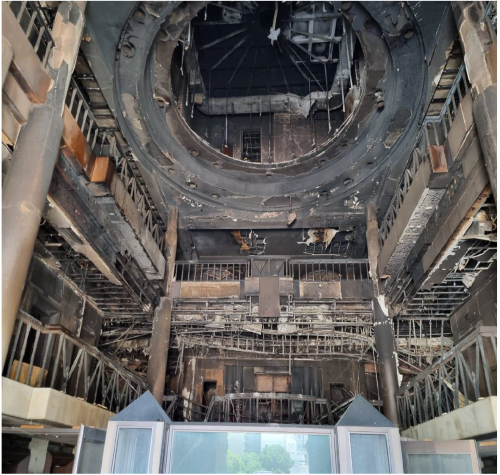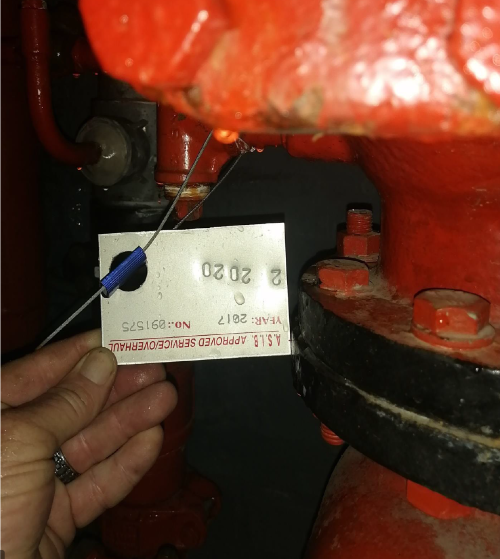04January 2022
CITY OF CAPE TOWN
SAFETY & SECURITY
FIRE AND RESCUE SERVICE
Fire & Life Safety Section
Table Bay District
04 January 2022
Fire at Parliamentary Complex:
Starting Sunday 02 January 2022
Please note that this is not an official fire report on the incident. It is for information purposes and provides the observations of City fire safety officers who worked on the scene.
Limitations on applicability of City of Cape Town fire by-laws and other applicable fire legislation:
1. In terms of the National Building Regulations and Building Standards Act: Application of the Act, section 2(3) –
Subject to the provisions of subsection (4) this Act shall not bind the State
Subsection 4 only requires the State to lodge plans to the Local Authority for its information and comment i.e. it does not require approval nor does it require final inspection and sign off. The State in effect is simply doing what it wants to, as there is no legislation to guide and enforce.
This is the problem with State owned buildings/premises – the NBR and part T cannot legally be applied.
2. Parliament is a National Key point, which further restricts the involvement of the City in the enforcement of fire regulations.
3. This has the consequence of exempting the national state from these laws and preventing the Fire Department from compelling compliance with fire safety standards for Parliament and other national state-owned assets.
Comments from Fire Safety Officers on Scene on Sunday:
Divisional Commander Wayne Visser:
As requested last night I did a brief check of fire suppression equipment and related fire safety matters at the “Old Assembly” parliament-building site.
The undermentioned refers:
- The external fire hydrants were well marked and maintained; adequate access provided
- The sprinkler control valve set on the southern façade of the Old Assembly building had not activated
- Sprinklers did not activate.
- The sprinklers were last serviced last in 2017, with service scheduled for 2.2020
- It is unclear which apportion of the building was actually fitted out with sprinklers
- The required layout block plan at the valve set was illegible
- General first aid fire suppression equipment (fire hose reels and fire extinguishers) were in-dated for service (11/2021), internal fire hydrants were operational with acceptable fire flow.
- Fire detection and alarm was present yet uncertain of extent of system, as extensive damage had occurred
- General fire informational signage was well presented although some non-SABS signs were found
- A major contributing factor to the excessive heat and smoke encountered throughout the building was the open-latching of fire doors onto the fire escape staircases using small metal latches
- The “rabbit warren” of locked office configurations off feeder passages negatively affected any ventilation occurring from inner spaces
- The emergency staircases were poorly ventilated with minimal natural vents encountered to the outside; no mechanical venting of the staircases was observed
- Wall panelling and décor materials presented additional fire loading throughout the building.
The above mentioned was observed between 16h00 and 23h30 on the night of 2.1.2022.
Station Commander JJ Williams.
I concur with Divisional Commander W Visser findings, however wish to add:
- During my walk around of the affected areas I found that the National Assembly sprinkler valve was not serviced (Service date was 02 2017 and this needs to be done every three years) and the valve appeared to be closed
- If properly serviced, this valve should have been locked with a chain in an open position and a block plan would have been available showing system lay out
- Lifts continued to operate despite a “break glass” unit at one lift being activated
- Fire doors were locked in an open position using latches
- Roof smoke vents did activate at the National Assembly.
Attached find previous courtesy inspections that were conducted by PC M Barendse at the venue at time of SONA in each year.
General Items:
1. The cause of the fire will be addressed in the official investigation and is not commented on here.
2. Fire extinguishers and hose reels appeared to have been serviced.
3. Fire detection system appears faulty (see images), but was badly damaged in fire. Its operational status still needs to be determined in the investigation.
4. Attached are the last three SONA reports submitted to Public Works noting numerous fire safety risks.
Areas of Concern:
1. The latching open of fire doors assisted in the spread of the fire.
2. Sprinkler system did not activate, was not serviced, valves appeared to have been closed. These should have been locked open with a chain.
3. Unclear what portions of the building are sprinkler fitted. Required block plan is not legible.
4. Unclear if fire alarm and detection system was operational. No fire alarm was received by Cape Town Fire Service from the old or new National Assembly buildings. An alarm was received after the fire fighters were already on scene from Tuynhuys adjacent to the assembly buildings.
5. HVAC system failed to shut down forcing City to isolate electricity to block.
6. Lift safety trip did not operate.
7. Some emergency staircases were overcome by smoke due to latching open of fire doors.
Annexed pictures where supplied by fire safety officers.
Digitally signed by Ian Schnetler Date: 2022.01.06 09:46:18
Ian Schnetler Ludwig Nisbet
Chief Fire Officer Divisional Commander: Fire and Life Safety
Gerard Langenhoven
Gerard Langenhoven
Digitally signed by Gerard Langenhoven
Date: 2022.01.06 09:11:49 +02'00'
Divisional Commander and Acting Head: Fire and Life Safety

***

Issued by the City of Cape Town, 7 January 2022


